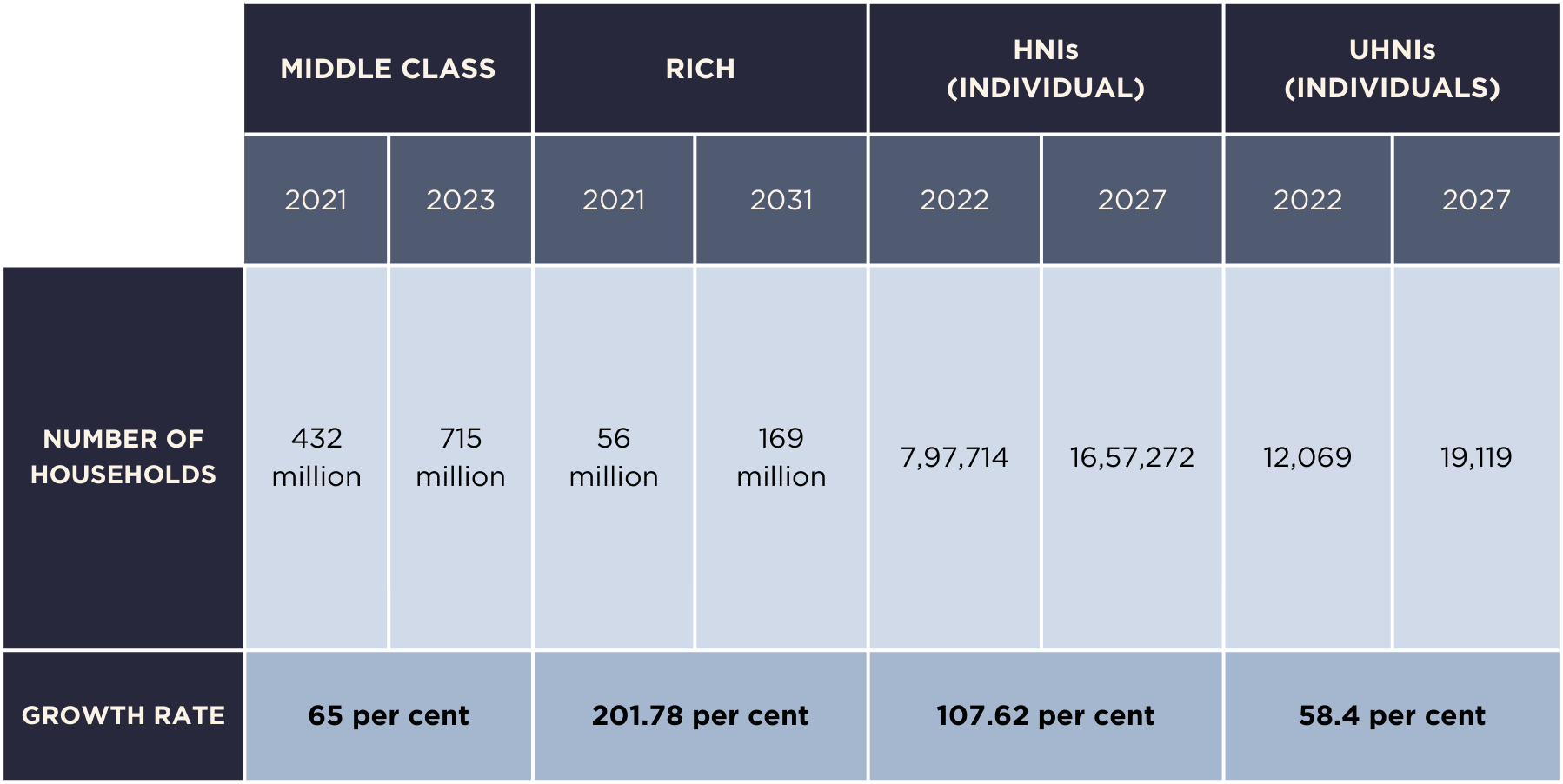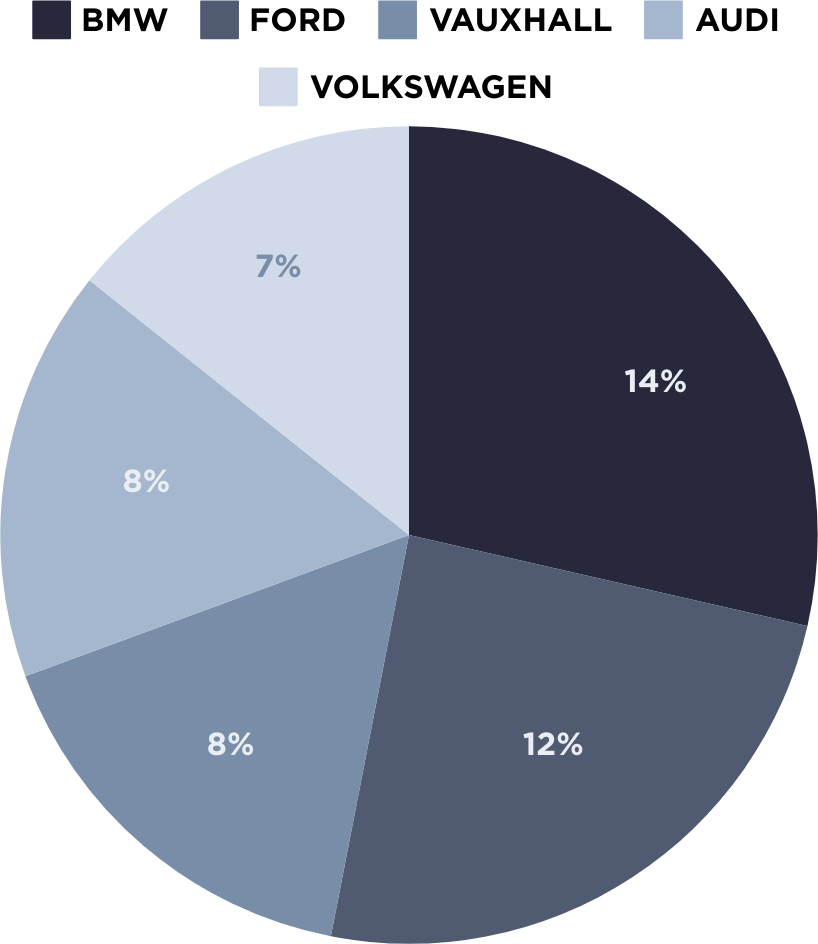
In the fast lane of contemporary India, a new class of drivers is gripping the wheel of luxury. Forget the sputtering Maruti 800s of a bygone era. Today’s young professionals, flush with stock options and even stockier paychecks, are leaving tyre tracks on a different kind of tarmac – the one demarcated by gleaming chrome and roaring engines.
This isn’t some fleeting infatuation with horsepower. It’s the harmony of rising incomes, a consumerist concerto, and a quiet downbeat in traditional investments. The Indian middle class, the engine of this phenomenon, is projected to reach a staggering 715 million by 2031.

Source: Financial Express, The Indian Express
This freshly minted affluence isn’t merely trickling down; it’s gushing forth, and luxury car showrooms are the new watering holes.
2023 has been quite a record-breaking year for the auto industry in India! BMW saw sales of 9,580 units between January and September, which resulted in a 10% increase over the previous year. The company also launched several new products across segments growing sales to the highest-ever monthly level of 1,439 units. Mercedes Benz India and Audi India weren’t just watching from the sidelines, either. They smashed their own records with sales soaring by 11% and a whopping 88% for the same period. This stands in stark contrast to the sluggish demand for entry-level vehicles, painting a picture of a shifting consumerist palette.
A lot of this can be attributed to the rising working population of Indian youth in urban areas, where working population ratio (WPR)1 for graduates among persons of age 15 years and above has increased to 58.3% in 2022-23 from 56.3% in 2021-22. Overall, it increased to 55.8% in 2022-23 from 53.9% in 2021-22. According to Goldman Sachs’ ‘The Rise of “Affluent India”’ report, Only ~4% of India’s working-age population has a per capita income of over US$10,000, projecting to ~60 million consumers. Corroborating data across tax filings, bank deposits, credit cards and broadband connections, it is estimated that this consumer cohort has grown at a 2019-23 CAGR of over 12%, compared to ~1% CAGR of India’s population. If the current trajectory continues, ‘Affluent India’ is expected to grow to ~100 million consumers by 2027.
India is experiencing a significant transformation, driven by a new class of individuals. By 2027, the number of millionaires in the country is expected to increase by 69%, with over 19,000 ultra-high-net-worth individuals with wealth exceeding $30 million, states Firstpost.
Beneath the gleaming chrome lies a more intriguing narrative. Ascending income levels, heightened consumer spending on discretionary items, and easy access to credit has placed these once-out-of-reach machines within grasp. This newfound financial muscle hints at a deeper play – a potential pivot from traditional investment strategies towards adventurous alternatives.
For decades, the Indian investor clung to the comforting solidity of real estate and the familiar glint of gold. However, the alternative investments – likes of private equity and venture capital – is finding a receptive audience amongst this young, risk-hungry demographic. The potential for exponential returns beckons, offering a compelling counterpoint to the sedated reliability of fixed deposits and ancestral properties.
The gleaming behemoths parked in driveways aren’t merely status symbols; they’re testaments to a generation’s comfort with financial risk. This comfort, in turn, translates into a willingness to explore avenues beyond the well-trodden path.
Young Indians, particularly those aged 18-35 and 35-45, are increasingly adopting riskier investment strategies for higher returns. According to White Oak Capital Mutual Fund, 28% of its 3.33 lakh investors belong to these age groups. They are digital natives, preferring technologically-centric financial service providers. And guess what? The majority of investors, 51%, come through digital channels at the age of 18-35.
Can you believe that globally, 1 in 6 youngsters have a BMW as their first car, making it the most popular choice? And if that wasn’t enough, 1 in 12 said they had an Audi for their first-ever vehicle. Increasingly embracing luxury, 39% of them are buying luxury cars, according to a report by CDK Global. This trend is particularly evident in their first car purchases.

Source: The Manufacturer
This shift in spending patterns is also causing ripple effects. The automotive industry is now trying to get into the mindset of a new generation of wealthy young entrepreneurs, startup professionals, and highly paid executives.
While luxury cars have their pricey charms, these young investors are not content with simply accumulating wheels. Discerning the limitations of gold and real estate, they’re casting their gaze towards a novel frontier: alternative investments.
Unlike their predecessors, fixated solely on the bottom line, this generation seeks symbiosis between financial returns and societal impact. Private equity and venture capital, once the playground of a chosen few, are now being actively explored, offering the allure of exponential growth alongside the potential to nurture businesses that chime with their conscience.
This newfound appetite for illiquidity is a stark contrast to the jittery short-termism that plagued past generations. Unburdened by the anxieties of their elders, they see long-term commitment not as a risk, but as an avenue for outsized returns. Unlike the quick-fingered exits of the old guard, these young investors are prepared to dig in and weather the inevitable storms, their focus firmly set on the horizon of long-term value creation.
Theirs is a calculated gamble, fueled not by FOMO (fear of missing out) or the specter of loss, but by a deeper conviction. Having cut their teeth in the dynamic world of startups, the young affluent in India possess an intimate grasp of the potential that lie within nascent ventures. Startups are no longer a speculative leap of faith, but a familiar territory brimming with the promise of disruptive innovation.
The young investors discern genuine potential where others see only risk, willing to weather the growing pains for a seat at the table of the future. This shift in mindset, a melding of financial acumen with a dash of social consciousness, is reshaping the landscape of wealth creation in India.
India’s love affair with luxury cars is more than just a flash in the pan. It’s a microcosm of a nation in flux, where young money meets a changing investment landscape. This new breed of driver isn’t just steering their vehicles down a different road; they’re potentially re-writing the investment rulebook for the future of India’s financial terrain.
1The worker population ratio (WPR) is the share of the working-age population that is actively working.
TERMS OF USE
Thank you for your interest in our Website at https://unlistedintel.com/. Your use of this Website, including the content, materials and information available on or through this Website (together, the “Materials”), is governed by these Terms of Use (these “Terms”). By using this Website, you acknowledge that you have read and agree to these Terms.
NO OFFER, SOLICITATION OR ADVICE
Our site is provided for informational purposes only. It does not constitute to constitute (i) an offer, or solicitation of an offer, to
purchase or sell any security, other assets, or service, (ii) investment, legal, business, or tax advice, or an offer to provide such advice or (iii) a basis for making any investment decision.
The Materials are provided for informational purposes and have been prepared by Oister Global for informational purposes to acquaint existing and prospective underlying funds, entrepreneurs, and other company founders with Oister Global's recent and historical investment activities.
Please note that any investments or portfolio companies referenced in the Materials are illustrative and do not reflect the performance of any Oister Global fund as a whole. There is no obligation for Oister Global to update or alter any forward-looking statements, whether as a result of new information, future events, or otherwise.
PURPOSE LIMITATION AND ACCESS TO YOUR PERSONAL DATA:
We will only collect your personal data in a fair, lawful, and transparent manner. We will keep your personal data accurate and up to date. We will process your personal data in line with your legal rights. We use your name and contact details, such as email, postal address, and contact number to continue communications with you. We may also use your contact information to invite you to events we are hosting or to keep you updated with our news.
USE OF COOKIES OR SIMILAR DEVICES
We use cookies on our website. This helps us to provide you with a better experience when you browse our website and also allows us to make improvements to our site. You may be able to change the preferences on your browser or device to prevent or limit your device’s acceptance of cookies, but this may prevent you from taking advantage of some of our features.
MATERIAL
The material displayed on our site is provided “as is”, without any guarantees, conditions, or warranties as to its accuracy, completeness, or reliability. You should be aware that a significant portion of the Materials includes or consists of information that has been provided by third parties and has not been validated or verified by us. In connection with our investment activities, we often become subject to a variety of confidentiality obligations to funds, investors, portfolio companies, and other third parties. Any statements we make may be affected by those confidentiality obligations, with the result that we may be prohibited from making full disclosures.
MISCELLANEOUS
This Website is operated and controlled by Oister Global in India. We may change the content on our site at any time. If the need arises, we may suspend access to our site, or close it indefinitely. We are under no obligation to update any material on our site.
CONTACT INFORMATION
Any questions, concerns or complaints regarding these Terms should be sent to info@oisterglobal.com